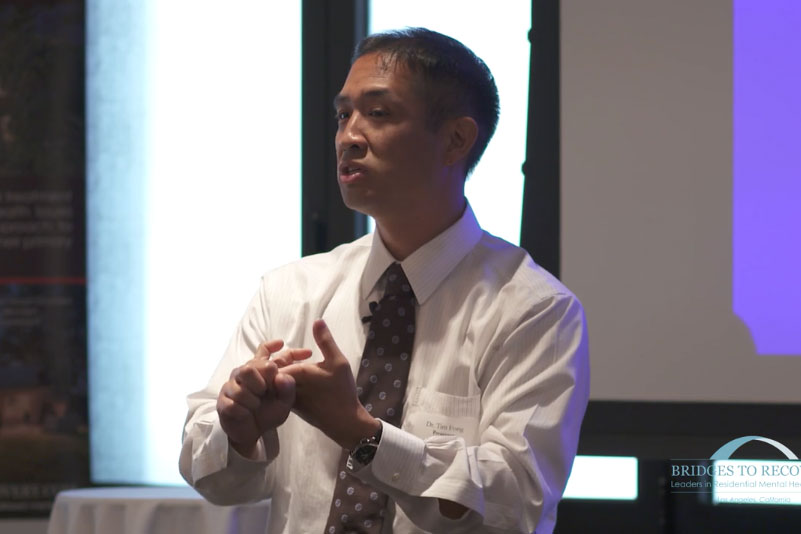How Clinicians Can Make A Difference in the Opioid Epidemic: Insights from Dr. Timothy Fong

On April 21st of this year, Bridges to Recovery presented the inaugural Innovations in Recovery Signature Luncheon, offering healthcare professionals the opportunity to network and learn about best practices in the field of addiction medicine. This year, we were honored to partner with Dr. Timothy Fong, Associate Clinical Professor of Psychiatry at the Semel Institute for Neuroscience and Human Behavior at UCLA, who presented a roadmap for clinicians to address the growing opioid epidemic. At a time when opioid addiction is reaching fever pitch and overdose deaths are rising in record numbers, Dr. Fong offers practical solutions that clinicians can immediately implement in their practices.
1. Recognize Opioid Use Disorder
Despite growing awareness of opioid addiction, many clinicians struggle to recognize opioid addiction in their own patients. “It’s hard sometimes to see it,” Dr. Fong explains. “It’s hard to recognize that maybe the reason my client isn’t sleeping, or the reason they’re depressed, or the reason their trauma isn’t getting better, is opiates.” And part of the reason it’s difficult to see it is that each person’s experience with opioid addiction is unique, leaving clinicians without a singular picture of what opioid addiction looks like.
While part of the answer lies in understanding the DSM-5 definition of opioid use disorder and developing the ability to accurately assess symptoms of both addiction and withdrawal, Dr. Fong believes that clinicians must also open up a dialogue with their patients to uncover addictions they themselves may not recognize. This begins by asking the right questions during screening. Questions such as “In the past year, how often have you used prescription drugs for non-medical reasons,” and “In the past year, how often have you used illegal drugs?” can invite clients into a conversation that illuminates their true relationship with opioids as well as other substances, allowing for accurate diagnosis.
2. Increase Access to Treatment
Access to opioid addiction treatment remains a significant concern, particularly at a time when greater numbers of people are both using and seeking help for their opioid use. “If you call UCLA right now to try to get access to one of our outpatient clinics, it might be six to eight weeks,” Dr. Fong says. “You think that’s going to work for someone with opiate use disorder who ran out of his supply on Friday afternoon and is ready to come in for treatment? Six to eight weeks isn’t going to work.” Increased access requires increased training, staffing, and funding for treatment to reduce wait times and offer clients the care they need when they need it.
However, treatment must be matched to the circumstances of each client, particularly when it comes to medication-assisted treatment. Although more medications are now available than ever before, not all treatments are appropriate for all clients; while methadone can be life-changing for some, for others it is an impractical and unrealistic treatment method. Similarly, buprenorphine (Suboxone) can significantly increase the chances of recovery, but only certain clients will commit to and benefit from buprenorphine treatment. Education is critical to ensuring that clinicians have the ability to tailor treatment to the needs of each client to optimize recovery.
For opioid addicts, clinicians must also consider the need for overdose treatment, and may prescribe opioid overdose medications along with withdrawal and maintenance medications. This year, the state of California took the remarkable step of passing a law that allows pharmacists to distribute Naloxone to anyone who wants it. Educating clients about this recent legislative change can empower addicts to protect themselves against overdose even if they do not currently have a prescription for Naloxone.
Begin Your Recovery Journey.
877-727-43433. Properly Dispose of Opiates
Most people who take prescription painkillers for non-medical reasons obtain those painkillers from a friend or relative, either openly or by stealing. Proper disposal of medications is imperative to ensuring that only those with legitimate opioid prescriptions access these medications. Dr. Fong believes that it is the responsibility of clinicians to inform clients about the options available for proper disposal, including medication take back programs and DEA-authorized collection sites.
Opioids, stimulants, and benzodiazepines, however, should never be thrown in the garbage, as “any time you have loose pills out there in circulation, someone will grab them.” Instead, these medications should be properly disposed of to erase the potential for misappropriation.
4. Reduce Overprescribing
The opioid epidemic can be traced back to a 15-year period of overprescribing that began in the 1990s. During that time, new opioid painkillers flooded the market and doctors prescribed them both out of a well-meaning desire to treat clients and for fear of getting sued. “You couple physician anxiety about treating pain, with a lot more choices to prescribe, with a pharmaceutical industry that was very aggressively promoting pain management treatment,” and you create a dangerous scenario in which millions of people suddenly had access to prescription opioids.
To prevent overprescription, the CDC has issued new guidelines for prescribing opioids for chronic pain that clinicians can use as a framework for responsible prescribing practices. In California, you may also refer to the Controlled Substance Utilization Review and Evaluation System (CURES) to see the client’s history of Schedule II, III, and IV prescriptions and identify potential misuse.
Preventing overprescribing isn’t just about your own prescribing practices, however; rather, it is a community effort. If you have clear evidence that another physician is prescribing to an addict, send the doctor a letter by mail outlining your concerns. If you do not receive a response, send a second letter. If you do not hear back about your second letter, you may file a complaint to the medical boards on the grounds of failed professionalism of communication, sending a strong message about the lack of communication regarding opioid prescription practices. “That’s where I think it has to be done,” Dr. Fong explains. “We don’t want to rat each other out, but we need to be talking to one another.”
5. Increase Partnerships
Truly making inroads into stopping the opioid epidemic as a whole and helping each client individually requires that clinicians work together and create networks that allow clients to quickly connect to the services they need. “You should be able to say, ‘Who can I refer to for immediate detoxification or for residential treatment or for an IOP or for a straight-up immediate assessment?’” This requires that each clinician educate themselves about the opioid addiction treatment resources available both locally and nationally and form partnerships with other providers. Participating in events such as the upcoming LA SBIRT Summit in July is a perfect opportunity to learn more about opioid addiction treatment and speak with others within the medical and recovery communities to expand your professional network and deepen your knowledge.
Call for a Free Confidential Assessment.
877-727-4343About Bridges to Recovery
At Bridges to Recovery, we are committed to improving the lives of people struggling with mental illness and helping them create the life they want to live. Our clinical team are experts in the treatment of even the most complex psychiatric disorders, and we provide a unique and effective combination of psychiatry, psychotherapy, and integrative therapy. It is our belief that true healing is best supported by combining evidence-based medical treatment with deep personal exploration to create extraordinary treatment experiences for our clients.
Bridges to Recovery is engaged in an outcome research study with Dr. Fong and the UCLA Department of Psychiatry, Strengthening the Bridge, designed to continuously improve the quality and effectiveness of our treatment. The study is evaluating quality of life improvements in our alumni post-treatment, so that we can continue to enhance the care we provide.
As a prominent organization within the treatment community, we also believe that we have a responsibility to support clinicians and create opportunities for sharing knowledge and facilitating vibrant dialogue to help those affected by addiction get the help they need. It is our hope that the Innovations in Recovery Signature Luncheon is the first of many to come, and that by working together, we can create brighter, more fulfilling futures for those we serve.
Bridges to Recovery offers comprehensive residential treatment for people struggling with mental health disorders as well as co-occurring substance use disorders. Contact us for more information about our innovative program and the vital work we do to help those struggling with opioid addiction.






